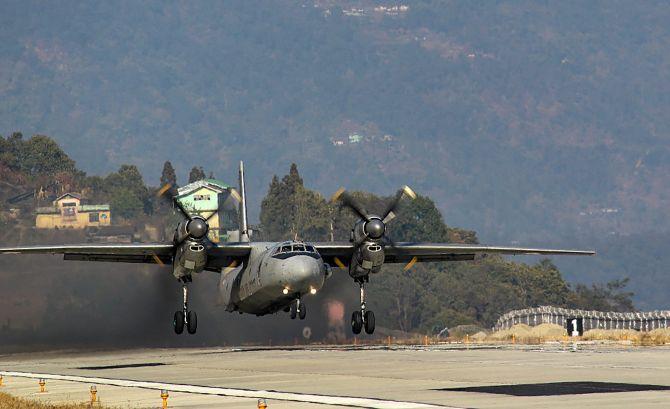 | « Back to article | Print this article |
'This is a huge step in promoting the 'Make in India' mission as this bio-fuel would be produced from Tree Borne Oils sourced from tribal areas and farmers.'
Ajai Shukla reports.

During the Republic Day parade on January 26, the Indian Air Force made a bold statement about its intent to go green by including an AN-32 transport aircraft, powered partly by biofuel, in the flypast over New Delhi.
On Friday, May 31, the door was opened to powering the broader IAF fleet with a blend of biofuel and normal aviation turbine fuel, when the Centre for Military Aviation Certification (CEMILAC) cleared the blending of 10 per cent biofuel across the entire fleet of over 100 AN-32 aircraft.
Each year, the IAF consumes about 1 billion litres of ATF to power its varied fleet. If 10 per cent biofuel use is extended across the fleet, 100 million litres of ATF would be saved each year.
The IAF's push for biofuel use originates from Prime Minister Narendra Damodardas Modi's call, in August 2017, for the country to save $1.7 billion a year on imported hydrocarbon fuel, by blending it with biofuel and ethanol.
Over the last year, the IAF has undertaken a series of evaluation tests and trials with green aviation fuel, culminating in official certification.
Indigenous bio-jet fuel was produced as far back as 2013 by a laboratory established in Dehradun by the Centre for Scientific and Industrial Research in partnership with the Indian Institute of Petroleum.
However, the fuel it developed, which is distilled from the Jatropha tree, could not be tested or certified for commercial use on aircraft since there are no test facilities in the civil aviation sector.
Eventually, CEMILAC, which is a Defence R&D Organisation laboratory, has evaluated and tested the fuel to international standards.
'This is a huge step in promoting the 'Make in India' mission as this bio-fuel would be produced from Tree Borne Oils (TBOs) sourced from tribal areas and farmers, augmenting their income substantially,' the IAF said.
On February 11, the Punjab government had extended this initiative to manufacturing biofuels from rice husk, which is burnt in late autumn, severely polluting Delhi.
Chief Minister Amarinder Singh presided over a ceremony in Chandigarh, also attended by US Ambassador to India Ken Juster, in which an Indian firm, Virgo Corporation inaugurated a project to produce biofuels from rice husk, using technology obtained from the US firm, Honeywell.
While only fuel made from jatropha has currently been certified, there is potential to source biofuels from 150 million tonnes of surplus bio-mass feedstock across India, including from non-edible plants like Castor Pongamia, Neem, Mahua, Sal and Kokum.
Ajai Shukla reports.

During the Republic Day parade on January 26, the Indian Air Force made a bold statement about its intent to go green by including an AN-32 transport aircraft, powered partly by biofuel, in the flypast over New Delhi.
On Friday, May 31, the door was opened to powering the broader IAF fleet with a blend of biofuel and normal aviation turbine fuel, when the Centre for Military Aviation Certification (CEMILAC) cleared the blending of 10 per cent biofuel across the entire fleet of over 100 AN-32 aircraft.
Each year, the IAF consumes about 1 billion litres of ATF to power its varied fleet. If 10 per cent biofuel use is extended across the fleet, 100 million litres of ATF would be saved each year.
The IAF's push for biofuel use originates from Prime Minister Narendra Damodardas Modi's call, in August 2017, for the country to save $1.7 billion a year on imported hydrocarbon fuel, by blending it with biofuel and ethanol.
Over the last year, the IAF has undertaken a series of evaluation tests and trials with green aviation fuel, culminating in official certification.
Indigenous bio-jet fuel was produced as far back as 2013 by a laboratory established in Dehradun by the Centre for Scientific and Industrial Research in partnership with the Indian Institute of Petroleum.
However, the fuel it developed, which is distilled from the Jatropha tree, could not be tested or certified for commercial use on aircraft since there are no test facilities in the civil aviation sector.
Eventually, CEMILAC, which is a Defence R&D Organisation laboratory, has evaluated and tested the fuel to international standards.
'This is a huge step in promoting the 'Make in India' mission as this bio-fuel would be produced from Tree Borne Oils (TBOs) sourced from tribal areas and farmers, augmenting their income substantially,' the IAF said.
On February 11, the Punjab government had extended this initiative to manufacturing biofuels from rice husk, which is burnt in late autumn, severely polluting Delhi.
Chief Minister Amarinder Singh presided over a ceremony in Chandigarh, also attended by US Ambassador to India Ken Juster, in which an Indian firm, Virgo Corporation inaugurated a project to produce biofuels from rice husk, using technology obtained from the US firm, Honeywell.
While only fuel made from Jatropha has currently been certified, there is potential to source biofuels from 150 million tonnes of surplus bio-mass feedstock across India, including from non-edible plants like Castor Pongamia, Neem, Mahua, Sal and Kokum. Converting edible crops to fuel remains controversial.
To extend biofuel use to civilian airliners, the IAF has recommended setting up an inter-ministerial Bio-Jet Fuel Board, and allocation of Rs 1,000 crore (Rs 10 billion) to set up three production plants of 5,000 litres per day, each using a different feedstock.